
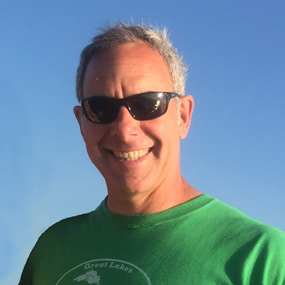
Co-Principal Investigator, NOAA Office of National Marine Sanctuaries
Russ Green is a maritime archaeologist and Great Lakes regional coordinator for NOAA’s Office of National Marine Sanctuaries. Russ has worked in the Great Lakes for 20 years, first as an underwater archaeologist for the state of Wisconsin and later as deputy superintendent at the Thunder Bay National Marine Sanctuary in Alpena, Michigan. He’s contributed to dozens of maritime archeology projects along the east and west coasts, Bermuda, Micronesia, and Japan and led several NOAA Ocean Exploration expeditions in the Great Lakes. An avid diver, he contributes regularly to NOAA’s documentation of the Civil War ironclad USS Monitor and World War II shipwrecks in North Carolina’s Graveyard of the Atlantic. Russ is a co-principal investigator for this expedition and currently leading start-up efforts for the new Wisconsin Shipwreck Coast National Marine Sanctuary.
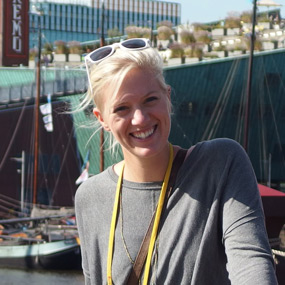
Co-Principal Investigator, NOAA Office of National Marine Sanctuaries Maritime Heritage Program
Madeline Roth is a maritime archaeologist with the NOAA Office of National Marine Sanctuaries’ Maritime Heritage Program. She received her bachelor’s degree in anthropology from St. Mary’s College of Maryland and holds a master’s degree in maritime studies from East Carolina University. Over the past decade, Madeline has been involved in archaeological projects throughout the United States, Caribbean, Africa, and Pacific. Prior work with the National Park Service instilled an interest in resource management that she has continued to pursue at NOAA. Additional research interests include heritage management, naval battlespaces, and conflict archaeology. Madeline has been conducting research in support of the proposed Lake Ontario National Marine Sanctuary designation and is as a co-principal investigator for this expedition.
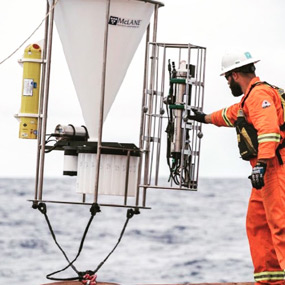
Maritime Archaeologist, Thunder Bay National Marine Sanctuary
John Bright is a maritime archaeologist with NOAA’s Thunder Bay National Marine Sanctuary. He has over 12 years of experience with scientific field operations involving maritime archaeology, geophysical survey, and oceanographic instrumentation preparation and deployment. His geophysical survey experience includes collection, processing, and delivery of data using a variety of sensors including navigation systems, multibeam sonar, single-beam sonar, side-scan sonar, and sub-bottom profile data as well as marine magnetic survey systems. His experience conducting seafloor mapping operations within academic, government, and private/commercial research programs has also included deployments of remotely operated vehicles, autonomous underwater vehicles, autonomous surface vehicles, and uncrewed aerial vehicles. John will assist the project with planning and coordination of technical aspects pertaining to mapping operations and assist with the management, processing, interpretation, and delivery of acquired survey datasets.
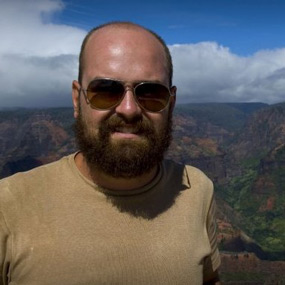
National Coordinator, NOAA Office of National Marine Sanctuaries Maritime Heritage Program
Joe Hoyt is the national coordinator for NOAA's Office of National Marine Sanctuaries Maritime Heritage Program. He specializes in archaeological recording of deepwater shipwrecks and has worked on several NOAA projects in the Thunder Bay, Florida Keys, and Monitor national marine sanctuaries since 2001. In 2004, he was awarded the North American Rolex Scholarship through the Our World Underwater Scholarship Society. He has worked on underwater archaeology projects in North and South America, Europe, the Great Lakes, Atlantic and Pacific oceans, and several inland rivers. Joe is also an avid underwater photographer and technical diver. He earned a master’s degree in maritime history and nautical archaeology from East Carolina University and serves on the Advisory Council for Underwater Archaeology.
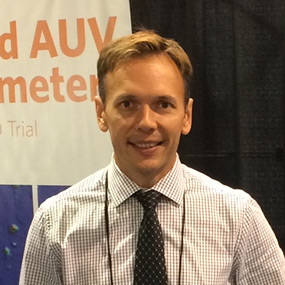
Geophysicist and Lead Engineer, Marine Magnetics
Ilya Inozemtsev is a geophysicist and lead engineer at Marine Magnetics. He holds a master’s degree in geophysics and a bachelor’s in geology and computer engineering and has had several years of experience planning and interpreting magnetic field surveys in both terrestrial and marine settings. For this expedition, he will assist with planning and conducting magnetometer surveys on all platforms used and data interpretation and will provide general guidance on magnetic surveying techniques.
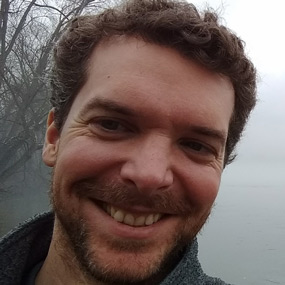
Spatial Ecologist, NOAA National Centers for Coastal Ocean Science
Charles Menza is a spatial ecologist and principal investigator at the NOAA National Centers for Coastal Ocean Science. He has 14 years of federal service with research focused on integrating remotely sensed imagery and species observations to map and model benthic habitats. For the past five years, he has been working in the Great Lakes to interpret lake bottom types, create habitat maps, and develop online data visualization tools for scientists and managers.
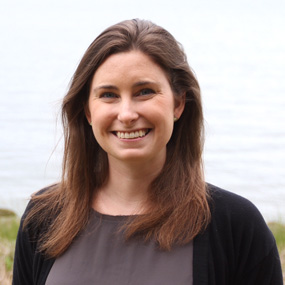
Research Associate, NOAA National Centers for Coastal Ocean Science Habitat Mapping Team
Avery Paxton is a research associate within the Habitat Mapping Team of the Biogeography Branch at the NOAA National Centers for Coastal Ocean Science (via a contract with CSS-Inc.). As a marine ecologist, Avery’s research often aims to understand ecological effects of human-made habitats, including artificial reefs, shipwrecks, and offshore renewable energy infrastructure. Avery and her colleagues use tools ranging from fishery echosounders and remotely operated vehicles to acoustic telemetry and scuba-diver surveys and specialize in creating visualizations from the data collected with these tools. She earned her doctorate from the University of North Carolina at Chapel Hill and her bachelor’s degree in environmental science from the University of Virginia.
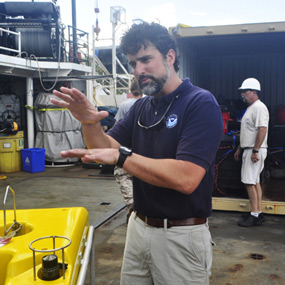
Senior Scientist, NOAA National Centers for Coastal Ocean Science Habitat Mapping Team
Chris Taylor is a senior scientist with the Habitat Mapping Team at the NOAA National Centers for Coastal Ocean Science. His research team uses scuba and remotely operated or autonomous vehicles with underwater acoustics and optical remote sensing technologies to observe the distribution of marine animals and to identify sensitive habitats and assess their ecological value in marine ecosystems. Outcomes from his research guides the planning for uses of the coastal ocean such as siting of offshore energy development, determines effectiveness and design of marine protected areas, and aids in the exploration of remote ocean environments. His team conducts research on shipwrecks and rocky reefs offshore North Carolina, coral reefs of Florida, pinnacles and coral banks of the Gulf of Mexico and the Caribbean, and from Alaska to Antarctica. Chris and his team have developed data visualization and interactive mapping techniques that make complicated scientific data more accessible. Chris received his master’s degree and doctorate in zoology from North Carolina State University and his bachelor’s degree in biology from University of Wisconsin – Stevens Point. He lives in Morehead City, North Carolina, with his wife and NOAA colleague Larisa Avens.
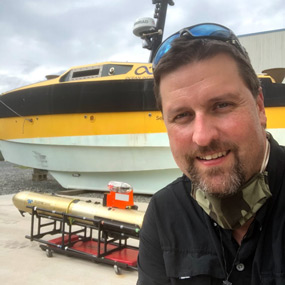
Professor, University of Delaware
Art Trembanis is a professor at the University of Delaware; director of the Coastal Sediments, Hydrodynamics, and Engineering Lab; co-founder of the Robotics Discovery Laboratory; and deputy director of the Center for Autonomous and Robotic Systems. He earned his doctorate from the Virginia Institute of Marine Science College of William and Mary and was a postdoctoral fellow at the Woods Hole Oceanographic Institution. He has over 20 years experience working with in situ oceanographic field observations and developing and using autonomous systems. His work entails collaborative exploration of the oceans, integrating geological, physical, and biological oceanography from rivers to the outer edge of the continental shelf. Ongoing topics of interest include beach erosion, sand ripple dynamics, scour processes associated with shipwrecks, artificial reefs, and unexploded ordnance. He has led multiple national and international expeditions for seafloor mapping and exploration and has been involved in several studies related to unexploded ordnance and seabed mine detection and dynamics. When he isn’t chasing robots around in the field, he enjoys travel with his family and mentoring the next generation of environmental roboticists. Art is leading the autonomous surface and underwater vehicle-based mapping operations of this expedition.
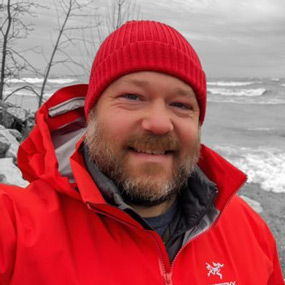
Fisheries Specialist, Wisconsin Sea Grant
Titus Seilheimer has been a fisheries specialist with Wisconsin Sea Grant since 2012. He leads research, outreach, and education activities focused on Great Lakes fisheries and ecosystems. He has a bachelor’s degree in biology from Lawrence University and a doctorate in biology from McMaster University. His past fish research took him to all five Great Lakes as well as the southern Great Plains. Titus has spent more than 100 days on Lake Michigan commercial fishing boats since 2015.